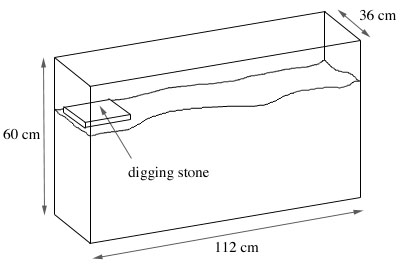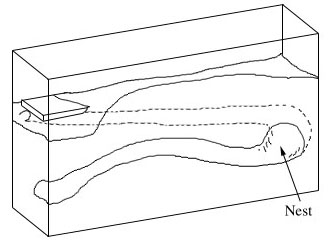I built a digging box for my pet rats a few years ago, using a ten gallon aquarium filled two thirds of the way up with potting soil. I placed my rats, Paint and Smudge, in there and they loved it. They started digging in one corner and eagerly dug a deep (6 inch) hole in one corner right down to the bottom of the aquarium. However, they couldn't dig a tunnel, because the dirt was too soft and crumbly.
Therefore, I've been on the lookout for a description of larger setup, something that would allow serious burrow and tunnel digging. I found just such a giant digging box in an article by Boice (1977). Boice studied digging behavior in wild and domestic rats. For this purpose, he constructed a glass-sided digging box, and tried many different soil combinations to find the one that worked best. Here are Boice's specifications:
Overall appearance
This is a wide, tall, shallow wooden box with glass sides. The box is large enough to allow the rats to dig tunnels and nest chambers, and the glass sides allow you to see the rats underground. It is filled with a special mixture of soils that (1) encourages rats to dig, (2) is strong enough to support tunnel walls, and (3) is moist enough to prevent excessive drying.
|
|
|
Figure 1. Drawing of glass-sided digging box. Adapted from Boice 1977. |
Specifications
Box dimensions: The box was made of soft pine lumber. It measured 112 cm wide x 60 cm tall x 36 cm deep. There were glass panes on the two largest sides measuring 100 cm wide x 50 cm tall to permit underground viewing. Exposed wood was covered with fine (0.25 in) wire mesh to prevent chewing, and the whole chamber had a 0.5 inch hardware cloth top with a hole for a water bottle.
Soil mixture: After much experimentation, Boice found that a mixture of 1/3 humus soil, 1/3 clay soil, and 1/3 sand encouraged burrowing but prevented the collapse or excessive drying of the tunnel walls.
Moisture: In the laboratory where this experiment was conducted, the ambient temperature was 20º C and the humidity 50%. To keep the dirt from getting dry, the dirt was dampened every other day with 1/6 of a gallon of water from a garden sprinkling can. The water was sprinkled evenly and slowly over the dirt.
Digging stone: To get the rats started, it was critical for them to be provided with a "digging stone," because rats prefer to begin digging under objects. Boice used a concrete patio stone (43 x 19 x 4 cm) placed on top of the dirt for this purpose.
Cleaning: Boice found that the surface dirt tended to solidify and get fouled by the rat. To keep the dirt clean, this surface dirt (about 20% of the total) was replaced every10 days. All the dirt was replaced every 30 days.
Length of stay: The digging box was not intended as permanent housing for rats. In this study, each rat stayed in the box for 10 days. When the 10 days were up, Boice removed the rat to a cage and studied the burrows. Then he replaced, smoothed and moistened the dirt (surface soil was replaced every 10 days, all soil every 30 days), and introduced a new rat into the digging box.
What did Boice's rats do in the digging box?
All rats placed in the digging box dug tunnels and burrow systems, except for older males. Most burrow digging occured in the first few days. All burrows started under the digging stone. Burrows typically consisted of an entrance tunnel followed by a nest chamber. Some burrow systems grew quite elaborate and had tunnels and chambers on more than one level, and some circled back to reconnect.
|
|
|
Figure 2. Drawing of a typical burrow system. The tunnel starts beneath the digging stone. The nest chamber is at the end of the first tunnel segment. A second tunnel wraps around the front of the box. If continued, it would probably have turned up into a bolt hole. Adapted from Boice 1977. |
If you enjoyed this page and would like to read more, visit
Disclaimer: I have not built the box described in this study. I do not vouch for its safety. Construct and use this box at your own risk.

